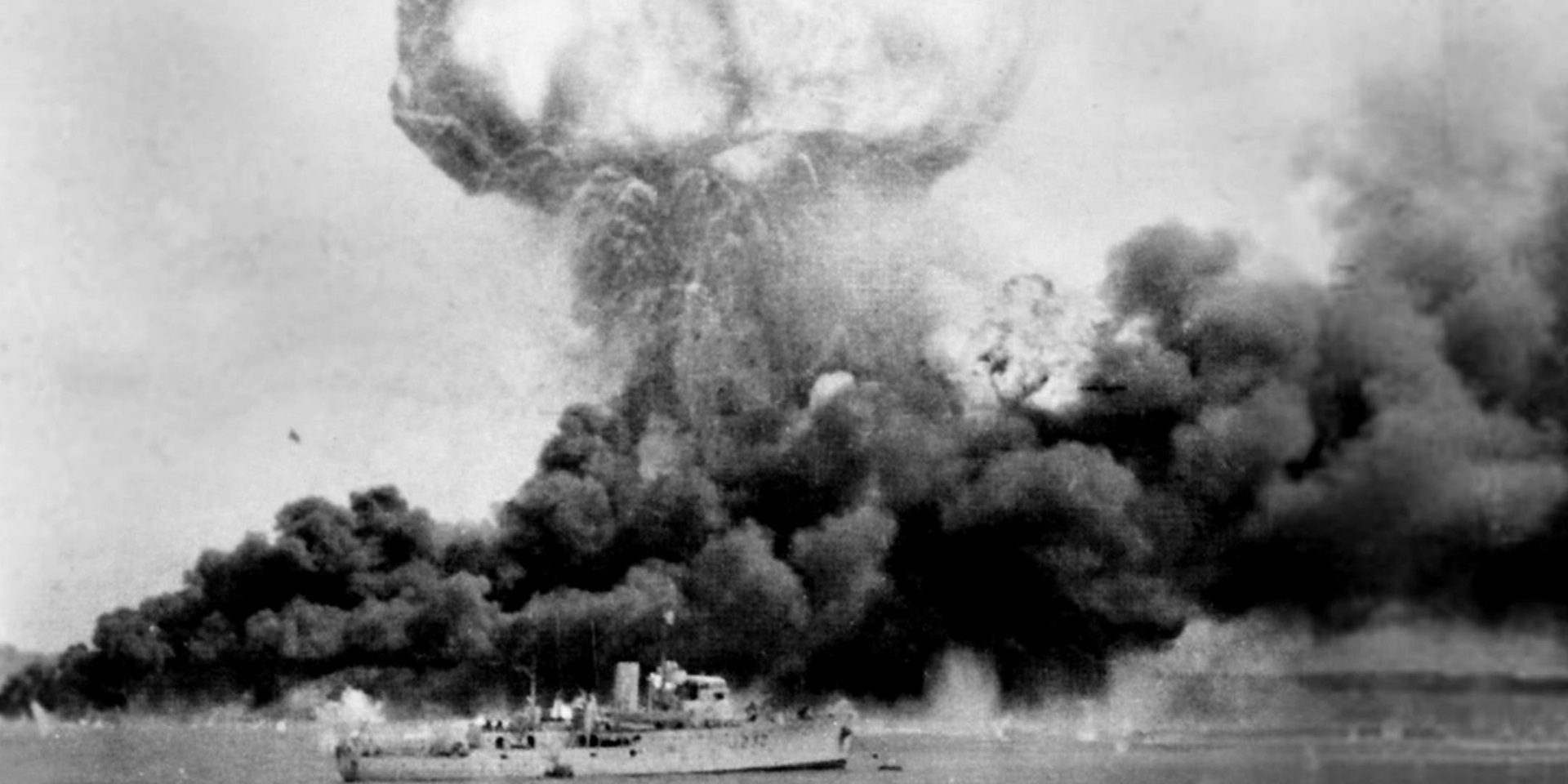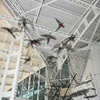
The Attack
The Bombing of Darwin was the first attack by Japanese forces on the Australian mainland after Australia had officially declared war on Japan on the 9th December 1941. Echoing their success at Pearl Harbor, the Japanese struck with stealth, speed and force, dropping 681 bombs weighing 114,000 kilograms with accuracy and minimal losses.
The build-up of military infrastructure including an RAAF base in Darwin from the late 1930s made the town a pivotal asset in the defence of the Dutch East Indies (Indonesia) and supply of US bases in the Philippines at the opening of the Pacific War. And a prime target for the Japanese.
There were 65 ships in Darwin Harbour on the morning of Thursday the 19th, mainly Royal Australian Navy vessels, a troopship (SS Zealandia) a hospital ship (HMAHS Manunda), merchant vessels and the American ships USS Peary, USS William B Preston, USAT Meigs and USAT Mauna Loa.
In Darwin Harbour a few days prior to the raid. Foreground HMAS SWAN, centre USAT MAUNA LOA and background HMAS WARREGO. Image: USA Naval History and Heritage Command.
At 9.58am, 188 fighters, dive bombers and torpedo bombers launched from Imperial Japanese Navy aircraft carriers Akagi, Kaga, Hiryū, and Sōryū (all veterans of the Attack on Pearl Harbor) arrived over Darwin Harbour at 9.58 devastating the fleet in port, the port itself, much of the town and taking hundreds of lives in a matter of 12 minutes.
Japanese aircraft carrier Akagi on April 5, 1942. Image: Kure Maritime Museum
A second raid by 54 land-based bombers stationed at Ambon and Kendari (Japanese occupied Indonesia) began at 10.58am extensively damaging the RAAF base and airport, killing 7 and destroying up to thirty RAAF and USAF aircraft.
At Darwin Harbour
The Americans suffered the greatest losses with the sinking of the destroyer USS Peary killing 88 of its crew, the sinking of freight carriers USAT Mauna Loa and Meigs with the loss of one man, and extensive damage to seaplane tender USS William B Preston killing fourteen.
USS Peary sinking. Image: Australian War Memorial 012970.
The Royal Australian Navy lost three men when HMAS Swan was struck, and another four when HMAS Kurra Kurra, Gunbar and Kangaroo were damaged. The lugger HMAS Mavie which had been seized from its Japanese owner in Darwin on 12 December was sunk with no loss of life.
The lugger Mavie in Darwin Harbour 1939, before being seized by the Royal Australian Navy from its Japanese owner in December 1941. Image: Northern Territory Library PH0082-001.
The merchant navy lost forty-one men and five vessels. Thirty-six crew and nine wharf labourers were killed when depth charges aboard MV Neptuna exploded.
The explosion of the MV Neptuna and clouds of smoke from oil storage tanks. In the foreground is HMAS Deloraine, which escaped damage. Image: Northern Territory Library, PH0238/0885.
At least thirty-nine civilians were killed on the wharf or in town, the US Army and Air Force lost nine men and another nine from the Australian Army and Air Force were killed.
There were two known Japanese casualties, four aircraft lost and one prisoner taken when Sergeant Hajime Toyoshima crash landed on Melville Island and became the first Japanese POW captured in Australia. Toyoshimi was interned at Cowra NSW and was instrumental in the mass break-out from that POW camp in August 1944.
Downed Japanese fighter aircraft A6M2, piloted by Hajime Toyoshima. Image: Australian War Memorial, A6M2_5349.
The hospital ship Manunda
Arriving in Australia in 1929, the 130m long, 9300 tonne TSMV Manunda provided a luxurious passenger service on the Adelaide Steamship Company’s Australian coastal service. Converted to a hospital ship in Sydney in June 1940, Manunda made four trips to and from the battlefields of the Middle East and Mediterranean until September 1941 when it was despatched to Darwin.
Manunda was hit during the attack, killing 12 crew and hospital staff and seriously injuring nineteen more. Under the command of Lt. Col. John Beith, and with Matron Clara Jane Shumack in charge of Australian Army Nursing Service staff the ship acted as a clearing station for the injured before making for Fremantle the next day with the seriously injured and for repairs.
Group portrait of nursing staff aboard the Australian Hospital Ship Manunda. ANMM Collection 00022396.
Adelaide Steamship Company hospital ship Manunda, August 1940. ANMM Collection 00022455.
Bathurst and Melville Islands (Tiwi Islands)
A third smaller raid in the afternoon attacked and sank the merchant ships SS Florence D and SS Don Isidro about 80km to the north of Darwin killing fifteen. That morning the Florence D had rescued the crew of a USAF Catalina flying boat shot down by Japanese fighters on their way to attack Darwin. Joseph Shuler, one of the rescued flight crew was killed when a bomb exploded almost on top of him on board the Florence D.
19th February 1942 WASHINGTON
On the other side of the world, on the day of the Darwin attacks, US President Franklin D Roosevelt signed into law Executive Order 9066 which authorized the relocation of any or all people from areas deemed to be of military significance. The US military then defined this area as the entire West Coast of continental USA, also the home of the majority of Japanese Americans.
Notice of internment camps for USA Japanese citizens. Image: National Parks Service
Given only days’ notice that they were to be relocated, Japanese American families often sold their farms and businesses at a loss and gave away or abandoned belongings before boarding buses and trains with only what they could carry.
Within four months more than 110,000 Japanese Americans were compulsorily relocated to ten remote internment camps in Arkansas, Arizona, California, Colorado, Idaho, Utah, and Wyoming. For two-and-a-half years, based on their ancestry, people endured extremely difficult living conditions surrounded by fences, barbed wire and watch towers and were often poorly treated by their military guards.
When only American-born internees were allowed to participate in the administration of the camps, it challenged traditional values and split families and relationships.
The Manzanar War Relocation Center, now a USA National Parks National Historical Site, located hundreds of kilometres from the California Coast became the subject of a photographic expedition by photographer Dorothea Lange. Lange had famously exposed the tragedy of the great depression through her documentary photography and because of her fame was commissioned by the US War Relocation Authority to record the relocation as an orderly and humane process. However, as an opponent of relocation, Lange’s photographs depicted the chaos and distress of people being taken away from their homes and the desolation of Manzanar.
American internees in mess hall line at Tanforan Assembly Center, San Bruno CA, April 29th 1942. Image: National Park Service, copyright Dorothea Lange.
The last US Relocation Camp closed in March 1946. In 1988 the US Congress awarded one off $20,000 compensation payments to survivors of the centres.
Acronyms
- HMAS – His Majesty’s Australian Ship
- HMAHS His Majesty’s Australian Hospital Ship
- MV – Motor Vessel
- POW – Prisoner of War
- RAAF – Royal Australian Air Force
- SS – Steam Ship
- TSMV – twin screw motor vessel
- USAF – United States Air Force
- USS – United States Ship
- USAT – United States Army Transport
